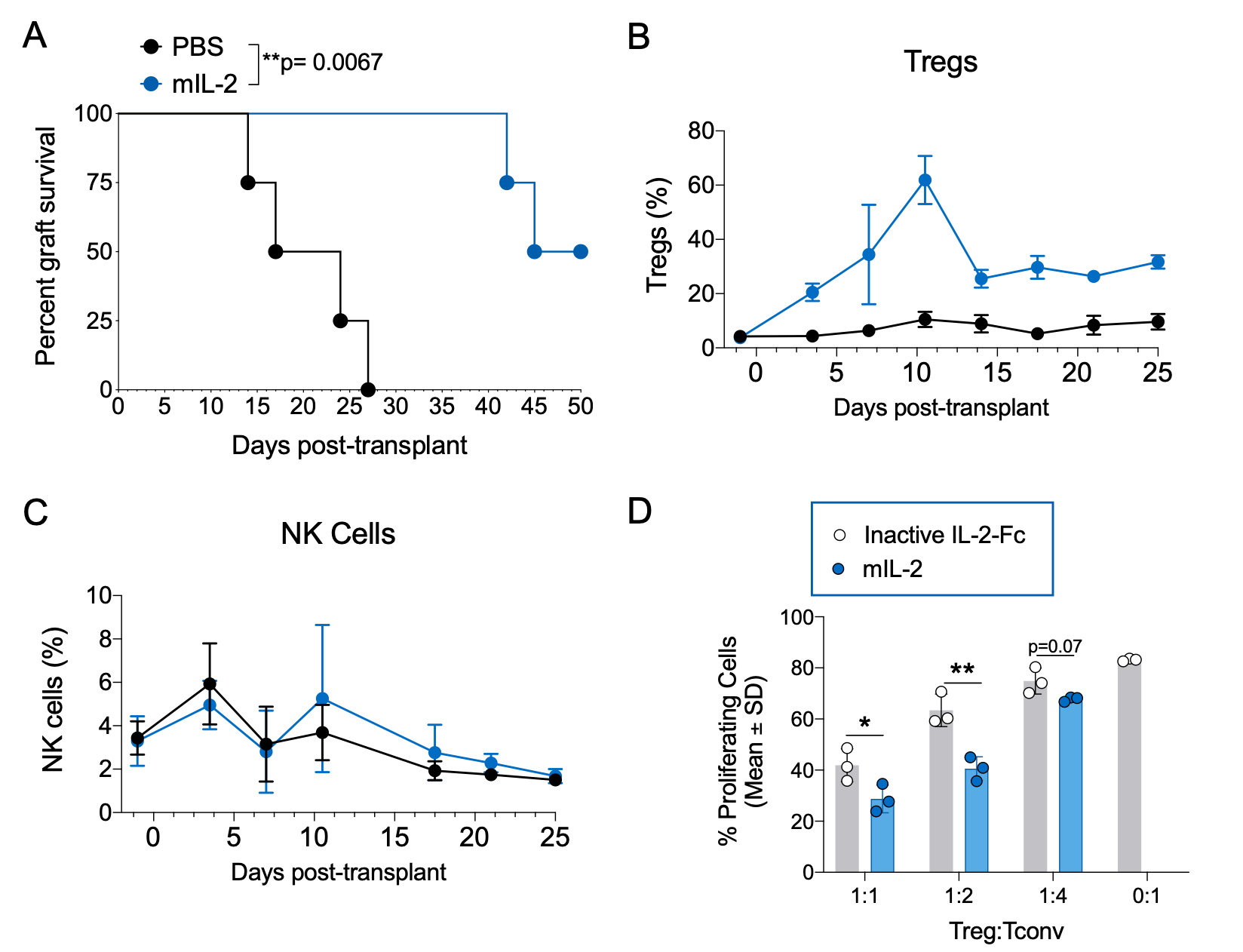Selective Regulatory T Cell Expansion by a Novel IL-2 Mutein Prolongs Skin Transplant Survival in Mice
1Center For Transplantation Sciences, Massachusetts General Hospital, Charlestown, MA, 2Visterra, Inc., Waltham, MA
Meeting: 2021 American Transplant Congress
Abstract number: 462
Keywords: Immunosuppression, Interleukin-2 receptor, N/A
Topic: Basic Science » Immunosuppression Preclinical Studies
Session Information
Session Time: 7:30pm-8:30pm
 Presentation Time: 7:50pm-8:00pm
Presentation Time: 7:50pm-8:00pm
Location: Virtual
*Purpose: Long-term immunosuppression predisposes transplant patients to a greater risk of infection, malignancy and kidney toxicity. Hence, alternative methods to regulate the immune system are needed. Low-dose IL-2 therapy has been reported to expand Tregs in vivo but can promote the proliferation of unwanted effector cells such as cytotoxic T cells and natural killer (NK) cells. This led us to develop and test a novel human IL-2 mutein (mIL-2) fused with a human antibody Fc domain (IL-2-Fc), designed to selectively induce Tregs with minimal effects on effector cells. Herein, we investigate the immune regulatory effects of mIL-2 in transplantation.
*Methods: We initially performed in vitro experiments in which we stimulated mouse splenocytes with the wild-type IL-2-Fc, the mIL-2, or negative control. We next performed a minor-mismatch murine skin transplant model, in which B6 males skins were transplanted into B6 females recipients (n= 4 mice/group). Mice were treated subcutaneously twice weekly with either PBS or 0.5 mg/kg of the mIL-2.
*Results: We found that the mIL-2 increased the levels of phosphorylated STAT5 (a downstream molecule of the IL-2 receptor) selectively in Tregs, with minimal effects on NK cells, non-Tregs CD4+ T cells, and CD8+ T cells. We next investigated whether mIL-2 treatment would lead to a sustained Treg expansion and prolongation of skin graft survival. We found that mIL-2 alone significantly prolonged the allograft survival when compared to the PBS group (MST 20.5 vs 47.5, p= 0.0067; Fig. 1A). The treatment with mIL-2 led to a significant increase in circulating Tregs, peaking at day 10 post-injection and followed by a stabilization of the Treg frequency at ~25% (Fig. 1B). Importantly, we observed no effect of mIL2 on effector immune cells such as NK cells (Fig. 1C), and CD8 T cells (not shown) when compared to the PBS group. Moreover, mIL-2 increased Tregs suppressive function as observed by an ex vivo suppression assay (Fig. 1D). Extending these findings, mIL-2 significantly expanded circulating Tregs with no detectable effects on Teff or NK cells in cynomolgus monkey (not shown). Our data also demonstrated that the mIL-2 has a >10-fold longer half-life than reported for recombinant IL-2.
*Conclusions: Overall, our data suggest that mIL-2 prolongs graft survival by the selective and sustained expansion of Tregs while also enhancing Treg function.
To cite this abstract in AMA style:
Borges TJ, Effe O, Gassen RB, Jurdi AAl, Lape IT, Babcock GJ, Carlson SM, Madsen JC, Riella LV. Selective Regulatory T Cell Expansion by a Novel IL-2 Mutein Prolongs Skin Transplant Survival in Mice [abstract]. Am J Transplant. 2021; 21 (suppl 3). https://atcmeetingabstracts.com/abstract/selective-regulatory-t-cell-expansion-by-a-novel-il-2-mutein-prolongs-skin-transplant-survival-in-mice/. Accessed December 15, 2025.« Back to 2021 American Transplant Congress

